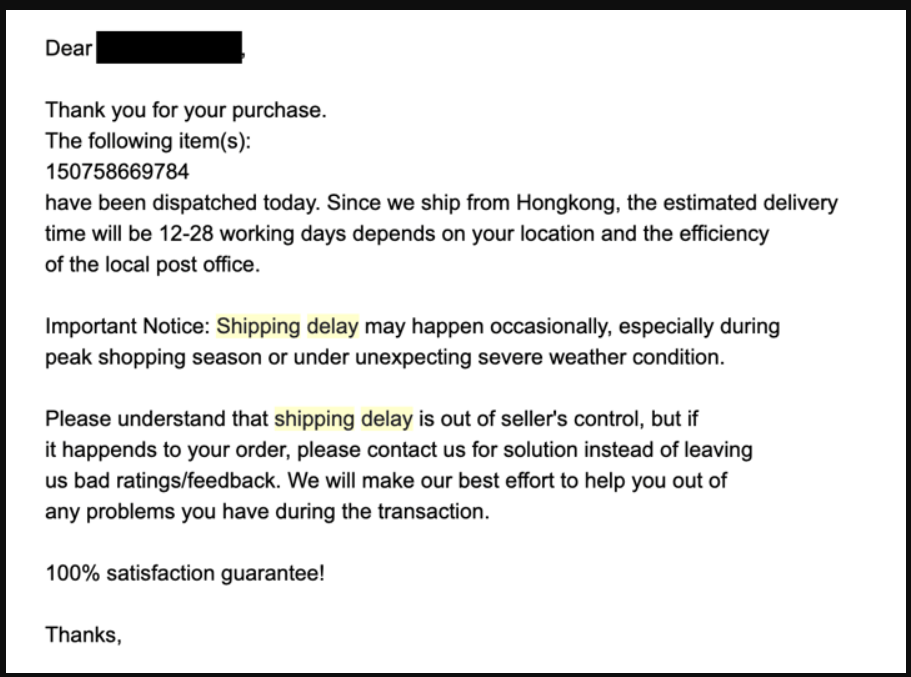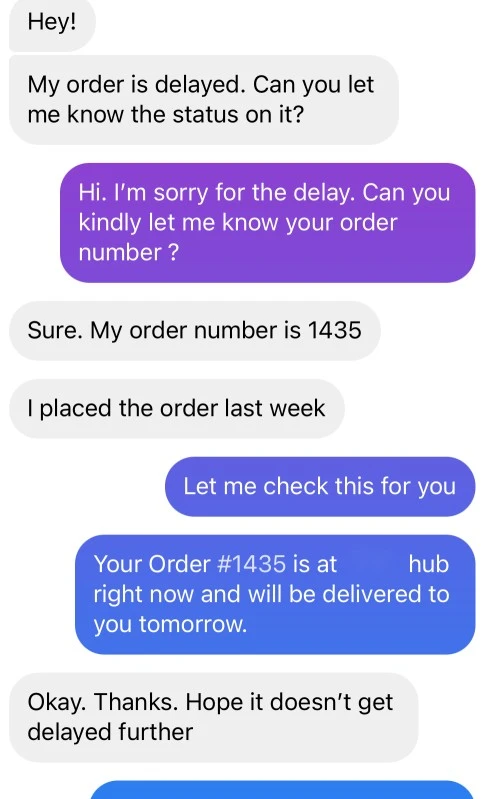How to Inform Customers About Order Delays

Since shipping comes with many uncertainties, it's important to make sure the issues do not go beyond your control. In this guide, we'll go over some steps and examples for communicating shipping delays with customers in order to ensure a smooth post-purchase experience. We'll also provide you with basic shipping delay communication examples to help you explain delays to customers.
We’ll cover:
- Steps for Communicating Delays to Customers
- Communicating Delays to Customers Examples
Steps for Communicating Delays to Customers
Set the right expectations
If you want to avoid customers becoming frustrated due to delayed deliveries, the best place to start is before orders are placed. Setting clear expectations for your customers allows them to make an informed decision about when and how they want to shop with you. It is critical to be transparent about what is in stock, how long it may take for items on back-order to become available, and the status of customers' orders at all times (if possible). For disruption like COVID-19 has caused for retailers and carrier networks, consider placing an information banner at the top of your website outlining the reasons for delays
Communicate regularly
Transparent communication is your best bet for dealing with shipping delays. When you become aware of a potential delay, the first and most important step is to contact your customer, then accept full responsibility and apologize for the inconvenience. Did you know? During COVID-19, 94% of online shoppers were willing to give retailers more time to deliver an item. It’s clear that your customers will more often than not understand the situation as long as you remain transparent. So, it is critical to explain the reason for the delay and maintain contact until the shipment is delivered.
Offer Free Shipping
Did you know that 66% of online shoppers expect free shipping on all purchases? Even though free shipping is so common, it's worth looking into the actual practice of free shipping, especially to work around order delays. Why? Offering free shipping is your opportunity to show your customers that you value them and are prepared to provide high-quality service. An additional benefit is that if other companies in your niche don't provide free shipping, doing so could give you an advantage over competitors. So, even if your orders experience unexpected shipping delays, offering free shipping can help improve customer perception and promote brand loyalty.
Automate when possible
Setting up automated messages/emails to keep customers updated on the status of their orders is another fix that ensures a more efficient process of dealing with shipping delays. Constant updates in your customer's post-purchase flow can assist in managing their expectations. Setting up automated messages also relieves you of the burden of manually providing more information to your customers. We’ll cover more on this later in this article.
Shipment Tracking
When waiting for deliveries, the majority of customers prefer to have the option to track their orders. 91% of consumers actively track their packages, according to research. By providing the tracking number to your customers, they can check the status of their packages' shipping and find out where they are. Customers can then determine whether a delay is the result of your company or the shipping carrier. Offering shipment tracking has the additional benefit of lowering the volume of support tickets from customers who want to know the status of their orders.70% of American consumers would rather continue to check tracking information than connect with customer service or the shipping company if their product shipment is delayed.
Offer compensation
Your customers don't need to understand that you can't control everything during the shipping process. This is why offers and incentives are an excellent way to reduce the frustration of your customers. Customers have certain expectations of your services when they choose you for your products. When there are delays, your overall goodwill suffers. Offering them attractive compensation could mitigate the damage to some extent.
Communicating Delays to Customers Examples
In addition to the steps we’ve mentioned above, we’ve also put together some examples of well-crafted communication to give you some insights. Keep in mind that these are only examples, so you can freely change them to suit your brand's voice, style, and situation.
Shipping delay message example
When it comes to communicating order delays, the first step is to accept full responsibility for the situation. Look at it from your customer’s perspective and consider what decisions and actions could lead to a smoother experience for them.

Source- www.getconvey.com
When sending SMS text messages, keep in mind that there is usually a character limit. So you’ll want to keep the message concise and highlight the most important information for your customers. You can even include links to your website, shipping information, additional information about the delay, etc.
Order delay email example
 Source- www.shippingchimp.com/
Source- www.shippingchimp.com/
Here’s what your shipping delay email can include:
- Provide Context It's not enough to simply inform your customers that there is a delay; you must also explain why. Provide information and keep your customers informed by providing adequate context.
- Describe your approach to resolving it It's critical to demonstrate your willingness to expedite the delay if it's within your power, as well as any steps you're taking to solve the problem.
- Updated Shipping Information Provide your customers with up-to-date shipping information to give them the peace of mind they require.
- Provide options It's natural for your customers to want to cancel. To work around this, we suggest you provide your customers with more options that are appealing than just canceling the order. Examples: Send out a new package, and provide them with a partial refund. As we covered earlier, providing compensation for their stress will go a long way to make their experience smoother.
Social media example
An important channel that you can use to communicate with your customers is social media, especially if a large chunk of your customers are from there. Here’s an example:

Source- https://instasell.io/
You can even put up a story or a post informing your customers about whatever issue you're dealing with and how you're dealing with it.
The takeaway from here is that you can never go wrong by having clear and honest conversations with your customers, even if they aren’t thrilled with the news you’re sharing.
Harness an Automated Solution
Let's face it: manually entering order details from one system to another and crafting messages for each customer can take a significant amount of time and resources. Instead, you can use an automated solution to streamline customer communication, freeing up your time to focus on growing your business.
Here's why a tool like Helplama Helpdesk can improve your customers' post-purchase experience:
- The Helplama Helpdesk is the only software that automatically detects delays and issues with your customers' orders by scanning orders every day. This can help you proactively resolve the situation with your customers.
- Helplama integrates email support as well as AI-drafted emails. This can significantly reduce your email traffic as well as your workload. You can set the tracking link to be sent to customers with the order shipping confirmation email.
- Integrate the Helplama Helpdesk with your store, as it provides a self-service returns center to generate and download return labels in one click for both your team and your customers.
- Include a live chat widget on your website to allow visitors to raise concerns in real-time.
Conclusion
Customers will always be disappointed when there is a delay; we've all been there. Setting up clear channels of communication for updates on where their package is, when it will arrive, and why it was delayed, on the other hand, could potentially help you mitigate the damage. Finally, the key to managing shipping delays and providing the best customer experience is to try to understand the customer's perspective. When most customers place an order, they are unaware of the various stages involved in the shipping process. So it is only reasonable to say that you should keep your customers updated with clear and transparent information.